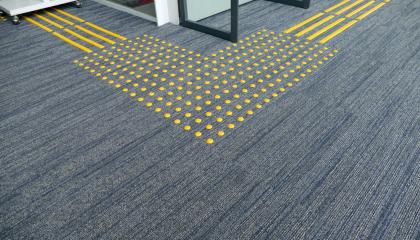At StrongGo, we aim to enhance urban accessibility with high-performance tactile warning surface indicators (TWSIs
Hosting a public event that is accessible and compliant with the Americans with Disabilities Act (ADA) is not only the right thing to do but also the law. Enacted in 1990, the ADA ensures that people with disabilities have equal access to public accommodations, including events. In this blog, we’ll discuss some tips for hosting an ADA-compliant public event that remains accessible to all attendees!
First and foremost, detectable warning tiles and surfaces were designed to assist individuals with disabilities to safely navigate public spaces, and then, in 1991, the Americans with Disabilities Act (ADA) mandated the use of detectable warning tiles in public areas throughout the United States.
Individuals with disabilities must navigate a world designed for people with vision and mobility, and one tool that helps to make the world more accessible is navigational bar tiles. These directional tile surfaces consist of raised bars that align with the direction of pedestrian travel. These navigational directional bar tiles help people to locate the entrance to light rails, trains, and bus stops.
A companion to detectable warning tiles, navigational and directional bar tiles serve an essential purpose of guiding individuals with disabilities in the flow of traffic.
People with impairments want to know the most accommodating airlines for domestic and international travel. When it comes to air travel, people with disabilities need an airline that has trained personnel to assist them through the terminals, sufficient space to accommodate the width of their assistive devices, and more time for situating themselves aboard the aircraft. Navigating while traveling is already a challenge, but for someone who has an impairment or disability, air travel can become nearly impossible.
For sidewalks and now websites, color ADA compliance ensures that people with low vision are able to see a clear contrast for viewing information. While the government requires a certain standard for public areas and websites, color ADA compliance is important for more reasons than just government conformity.
On Monday, March 18th, Google Doodle featured the Japanese inventor of detectable dome tiles, Seiichi Miyake. His invention changed the world by empowering and protecting individuals with visual impairments to cross streets with greater ease. Fifty-two years have passed since the first dome tiles were installed, and these detectable warning tiles are now part of many cities throughout the world.
The Americans with Disabilities Act (ADA) expects workplaces and public areas to be accessible for people with disabilities. Since 1990, businesses and communities strive to meet these requirements. For example, public areas must take steps to remove barriers and add domed-tile curb ramps to improve accessibility and safety for people with impairments. Buildings constructed before 1990 must make adjustments, but buildings built after 1990 must be ADA compliant.
Connect with us
We pride ourselves on our customer service, and we'd love to hear from you! Sign up for our newsletter to keep up with industry updates and trends, as well as any new product releases.










